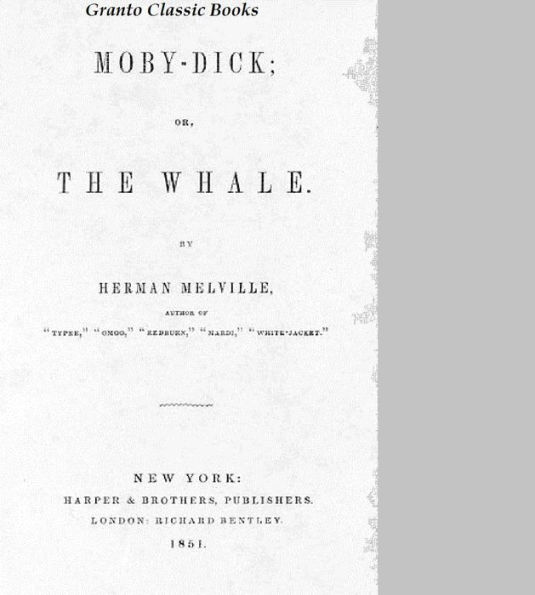Moby Dick ( Classic Series) with Etymology by Herman Melville
Moby-Dick, also known as The Whale,[1] is a novel first published in 1851 by American author Herman Melville. Moby-Dick is widely considered to be a Great American Novel and a treasure of world literature. The story tells the adventures of the wandering sailor Ishmael, and his voyage on the whaleship Pequod, commanded by Captain Ahab. Ishmael soon learns that Ahab seeks one specific whale: Moby Dick, a ferocious, enigmatic white sperm whale. In a previous encounter, the whale destroyed Ahab's boat and bit off his leg. Ahab intends to take revenge.
In Moby-Dick, Melville employs stylized language, symbolism, and metaphor to explore numerous complex themes. Through the main character's journey, the concepts of class and social status, good and evil, and the existence of gods are all examined as Ishmael speculates upon his personal beliefs and his place in the universe. The narrator's reflections, along with his descriptions of a sailor's life aboard a whaling ship, are woven into the narrative along with Shakespearean literary devices such as stage directions, extended soliloquies, and asides. The book portrays insecurity that is still seen today when it comes to non-human beings along with the belief that these beings understand and act like humans. The story is based on the actual events around the whaleship Essex, which was attacked by a sperm whale while at sea and sank.[2][3][4]
1115946364
In Moby-Dick, Melville employs stylized language, symbolism, and metaphor to explore numerous complex themes. Through the main character's journey, the concepts of class and social status, good and evil, and the existence of gods are all examined as Ishmael speculates upon his personal beliefs and his place in the universe. The narrator's reflections, along with his descriptions of a sailor's life aboard a whaling ship, are woven into the narrative along with Shakespearean literary devices such as stage directions, extended soliloquies, and asides. The book portrays insecurity that is still seen today when it comes to non-human beings along with the belief that these beings understand and act like humans. The story is based on the actual events around the whaleship Essex, which was attacked by a sperm whale while at sea and sank.[2][3][4]
Moby Dick ( Classic Series) with Etymology by Herman Melville
Moby-Dick, also known as The Whale,[1] is a novel first published in 1851 by American author Herman Melville. Moby-Dick is widely considered to be a Great American Novel and a treasure of world literature. The story tells the adventures of the wandering sailor Ishmael, and his voyage on the whaleship Pequod, commanded by Captain Ahab. Ishmael soon learns that Ahab seeks one specific whale: Moby Dick, a ferocious, enigmatic white sperm whale. In a previous encounter, the whale destroyed Ahab's boat and bit off his leg. Ahab intends to take revenge.
In Moby-Dick, Melville employs stylized language, symbolism, and metaphor to explore numerous complex themes. Through the main character's journey, the concepts of class and social status, good and evil, and the existence of gods are all examined as Ishmael speculates upon his personal beliefs and his place in the universe. The narrator's reflections, along with his descriptions of a sailor's life aboard a whaling ship, are woven into the narrative along with Shakespearean literary devices such as stage directions, extended soliloquies, and asides. The book portrays insecurity that is still seen today when it comes to non-human beings along with the belief that these beings understand and act like humans. The story is based on the actual events around the whaleship Essex, which was attacked by a sperm whale while at sea and sank.[2][3][4]
In Moby-Dick, Melville employs stylized language, symbolism, and metaphor to explore numerous complex themes. Through the main character's journey, the concepts of class and social status, good and evil, and the existence of gods are all examined as Ishmael speculates upon his personal beliefs and his place in the universe. The narrator's reflections, along with his descriptions of a sailor's life aboard a whaling ship, are woven into the narrative along with Shakespearean literary devices such as stage directions, extended soliloquies, and asides. The book portrays insecurity that is still seen today when it comes to non-human beings along with the belief that these beings understand and act like humans. The story is based on the actual events around the whaleship Essex, which was attacked by a sperm whale while at sea and sank.[2][3][4]
3.59
In Stock
5
1

Moby Dick ( Classic Series) with Etymology by Herman Melville

Moby Dick ( Classic Series) with Etymology by Herman Melville
eBook
$3.59
Related collections and offers
3.59
In Stock

Product Details
| BN ID: | 2940012960627 |
|---|---|
| Publisher: | Granto Classic Books |
| Publication date: | 06/16/2011 |
| Sold by: | Barnes & Noble |
| Format: | eBook |
| File size: | 776 KB |
About the Author
From the B&N Reads Blog
